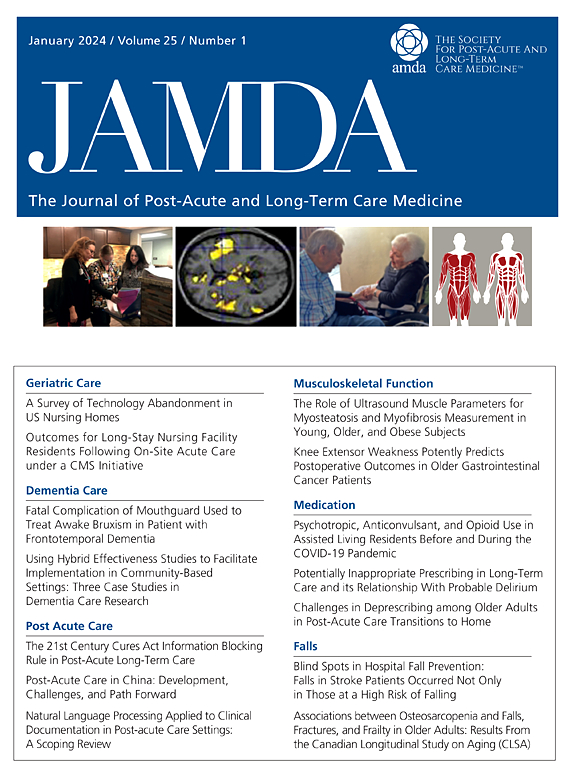Comparative Study of Frailty Assessment Measures in Predicting All-Cause Mortality: Insights From NHANES
IF 4.2
2区 医学
Q2 GERIATRICS & GERONTOLOGY
Journal of the American Medical Directors Association
Pub Date : 2025-02-01
DOI:10.1016/j.jamda.2024.105464
引用次数: 0
Abstract
Objectives
The 3 most frequently utilized frailty assessment measures are the Fried criteria, FRAIL scale, and Frailty Index (FI). This study aimed to compare predictive capabilities of these 3 measures regarding all-cause mortality in the United States and to identify the key predictive variables.
Design
Cross-sectional study.
Setting and Participants
From the National Health and Nutrition Examination Survey (NHANES) 2005–2018 cycles, a total of 39,631 participants aged 20 and older were included.
Methods
Fried status, FRAIL status, and FI status were determined for each individual based on the cutoff values from the continuous scores of their respective scales. Univariate and multivariate models, incorporating 11 covariates—sex, age, body mass index, ethnicity, education, marital status, smoking status, alcohol intake, employment status, poverty-to-income ratio, and total energy intake—were fitted using Cox proportional hazards and 2 machine learning models. Model performance was assessed through Integrated Brier Score (IBS), concordance index (C-index), and area under the curve (AUC) values from 10-fold cross-validation. Key variable analysis was performed using permutation importance and C-index increment. Subgroup analysis was developed according to age.
Results
In univariate analyses, FI consistently outperformed Fried and FRAIL, showing significantly lower IBS, and higher C-index and AUC values. In multivariate analyses, few significant differences were found. Permutation importance analysis identified age as the most important variable, followed by Fried status and FI status. Similarly, in C-index increment analysis, age was the top one variable. Subgroup analyses showed that FI status consistently performed best in all metrics across univariate analyses at least in 40–59 and 60–79 age groups. FI status consistently emerged as the most important variable in permutation analysis across all age groups.
Conclusions and Implications
FI demonstrated the best performance as a single predictor in predicting all-cause mortality, with age being crucial for enhancing predictive performance. Future research should explore the applicability of FI in different populations and its relationship with cause-specific mortality.
预测全因死亡率的衰弱评估方法的比较研究:来自NHANES的见解。
目的:最常用的3种虚弱评估方法是弗里德标准、虚弱量表和虚弱指数(FI)。本研究旨在比较这三种方法对美国全因死亡率的预测能力,并确定关键的预测变量。设计:横断面研究。环境和参与者:从2005-2018年的国家健康和营养检查调查(NHANES)周期中,共有39,631名20岁及以上的参与者被纳入研究。方法:根据各自量表连续得分的截止值,确定每个个体的油炸状态、虚弱状态和FI状态。采用Cox比例风险和2个机器学习模型拟合单变量和多变量模型,包括性别、年龄、体重指数、种族、教育程度、婚姻状况、吸烟状况、饮酒状况、就业状况、贫困收入比和总能量摄入等11个协变量。通过综合Brier评分(IBS)、一致性指数(C-index)和10倍交叉验证的曲线下面积(AUC)值来评估模型的性能。关键变量分析采用排列重要性和c指数增量。根据年龄进行亚组分析。结果:在单变量分析中,FI的表现始终优于Fried和weak,表现出明显较低的IBS,较高的c指数和AUC值。在多变量分析中,没有发现显著差异。排列重要性分析发现年龄是最重要的变量,其次是Fried状态和FI状态。同样,在c指数增量分析中,年龄是排名前一的变量。亚组分析显示,至少在40-59岁和60-79岁年龄组中,FI状态在单变量分析的所有指标中始终表现最佳。在所有年龄组的排列分析中,FI状态一直是最重要的变量。结论和意义:FI作为预测全因死亡率的单一预测指标表现最佳,年龄是提高预测性能的关键。未来的研究应探讨FI在不同人群中的适用性及其与病因特异性死亡率的关系。
本文章由计算机程序翻译,如有差异,请以英文原文为准。
求助全文
约1分钟内获得全文
求助全文
来源期刊
CiteScore
11.10
自引率
6.60%
发文量
472
审稿时长
44 days
期刊介绍:
JAMDA, the official journal of AMDA - The Society for Post-Acute and Long-Term Care Medicine, is a leading peer-reviewed publication that offers practical information and research geared towards healthcare professionals in the post-acute and long-term care fields. It is also a valuable resource for policy-makers, organizational leaders, educators, and advocates.
The journal provides essential information for various healthcare professionals such as medical directors, attending physicians, nurses, consultant pharmacists, geriatric psychiatrists, nurse practitioners, physician assistants, physical and occupational therapists, social workers, and others involved in providing, overseeing, and promoting quality

 求助内容:
求助内容: 应助结果提醒方式:
应助结果提醒方式:


